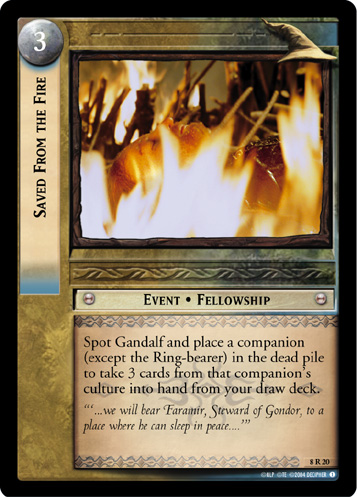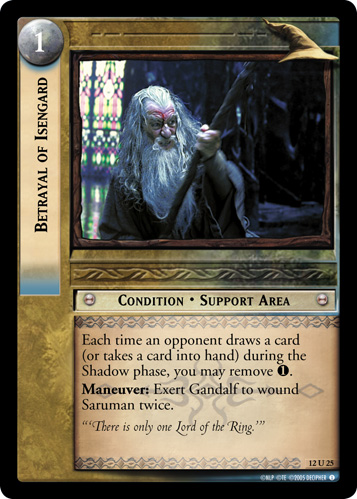Betrayal of Isengard (3R29)
Back to Realms of the Elf-Lords Index |
Deep in Thought (3C30) |
Betrayal of Isengard (3R29) is a Gandalf Condition from the Realms of the Elf-Lords set.
| ||||||||||||||||||||
| ||||||||||||||||||||
| ||||||||||||||||||||
Strategy[edit]
Betrayal of Isengard is one of those cards that at first look, appears to be useful only against specific opponents, but on further consideration turn out to be so broadly useful that it could make an appearance in just about every deck centered on Gandalf.
Betrayal is obviously of most use against Isengard, the culture that contains the most versions of Saruman. In fact it's just about the only way to practically neutralize Saruman, Keeper of Isengard, which in today's tournament environment, where Uruk-Hai are heavily represented, can easily be the difference between winning and losing. With the upcoming release of the potentially popular new Saruman, Master of Foul Folk, in The Battle Of Helm's Deep set, Gandalf will be confirmed as Isengard's worst enemy, and Betrayal of Isengard will be the keystone in that confrontation.
Of course, Dunland's Saruman, Rabble-Rouser, also has much to fear from Betrayal. A single exertion on Gandalf's part can largely neutralize the skirmish-enhancing capability of the Rabble-Rouser, leaving him with a much less useful +2 to offer, in turn making it more likely that there won't be that many Dunland Men still around to cause exertions should the Free Peoples player move in the regroup phase.
While Betrayal's major benefit is directly against the various Sarumans, the other part of its game text can also useful, particularly against those cultures that use a lot of card manipulation, such as Moria - most of which cultures, not coincidently, don't have a Saruman card. This twilight removal can also come in handy in potentially dangerous situations such as the Site 8 card drawing enabled for Dunland by Ring of Isengard, or one common way to extend an Isengard swarm, Abandoning Reason For Madness.
Even in the cases where it isn't useful, Betrayal doesn't have some of the drawbacks that other Gandalf culture cards do. In particular, it can be played without having to spot Gandalf, so won't clog up your hand if you haven't drawn any of those four copies of Friend Of The Shirefolk yet.
So, useful against many of the deck archetypes commonly found in tournament play, and requiring just one card slot to use effectively (though it's not unique, and it's effectiveness can only be increased by having multiple copies on the table), it's no wonder Betrayal of Isengard makes its way into most Gandalf decks.
Strengths and Weaknesses[edit]
Synergizes With...[edit]
- List friendly cards that work well with this card
Strong Versus...[edit]
- List enemy cards this card does well against
Weak Versus...[edit]
- List enemy or friendly cards to avoid playing this card with
Rulings[edit]
In this section:
- Put quotes from the CRDs and Comprehensive Rules here that reference this card specifically by name
- Also put quotes if a particular rule commonly affects the outcome of a card in a subtle manner (such as quoting the Rule of 4 for Saved From the Fire (8R20)
 )
) - Link to rules discussions on TLHH
Alternate Versions[edit]
| Portrait | Name | Game Text |
|---|---|---|
Betrayal of Isengard (12U25)

|
Each time an opponent draws a card (or takes a card into hand) during the Shadow phase, you may remove Maneuver: Exert Gandalf to wound Saruman twice. |
See Also[edit]
- Add links to the wayback machine (or wiki archival links) for official Decipher articles regarding the card
- Link to decks that use this card








